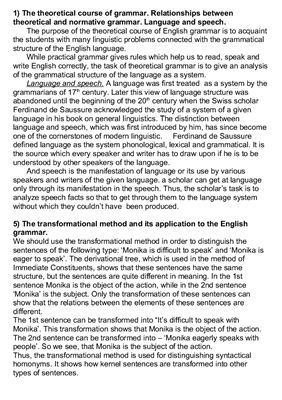The theoretical course of Grammar. Relationships between
theoretical and normative grammar. Language and Speech.
Grammar and Phonetics. Grammar and Lexicology.
Methods of grammatical investigation. The distributional method and its application to the English language.
The method of I.C. and its application to the English language.
The transformational method. Its application to the English grammar.
The notion of opposition in Grammar. (Nouns, verbs, adjectives)
Morphology and Syntax. Their relationship and boundary lines between them.
The notions of grammatical Meaning and grammatical forms as applied to the English language.
Grammatical categories in Mode English.
Basic morphological notions: word-morpheme, morph, allomorph.
Types of word-form derivation in English. Inflectional morphemes, sound alteation, zero morpheme.
Analytical forms, supletivity, grammatical homonymy.
s of speech. The notion of parts of speech. Difficulties of the problem. Criteria applied in discriminating parts of speech: meaning, form and function.
Controversy in Parts of Speech. Classification of Parts of Speech.
Charles Fries classification of words and its character.
The Noun. Its definition, grammatical meaning, morphological characteristics, syntactical functions.
The Noun. Its grammatical categories. Problem of gender in Mode English.
The Noun. The category of number and its peculiarities in the English Noun. Singularia Tantum and Pluralia Tantum.
The Noun. The category of number and its peculiarities in the English Noun. Collective Nouns and Nouns of Multitude.
The Noun. The category of case. Different approaches to the category of case in Mode English. Mutual Relations of Number and Case.
The Non-finates. Their form, meaning and function. Double character of Verbals.
The Verb. Its definition, grammatical meaning and morphological classification of verbs.
The Verb. Sematic-syntactical classification of verbs.
The Verb. The problem of aspect. Definition of this category. English and Russian aspects compared.
Controversy conseing the category of aspect. Assessments of different approaches to continious forms.
The Verb. The category of tense, its definition. System of tenses in the English Verb.
The Verb. The Perfect. Controversy conceing the essence of perfect forms. Assessments of different views on the problem. The category of time correlation.
The Verb. The category of Mood. Definition, different conceptions of the mood system in English and objective reasons for the existing controversy.
The Verb. The category of Voice, its definition. Different views on the problem. Relationship of voice and transitivity and intransitivity of verbs.
The Verb. The category of Voice, its definition. Different views on the problem. The question of the reflexive voice.
The problem of the subject matter of Syntax. Basic syntactical notions. The phrase and the sentence.
Syntax. The Phrase Definition, types of phrases.
The Phrase. Ways of expressing syntactical relations within a phrase (agreement, govement, adjoinment, enclosure)
The Sentence. Classification of sentences according to communicative types.
The Sentence. Classification of sentences according to their structure.
The Sentence. Types of coordination within the compound sentence.
The Sentence. Types of complex sentences. Their structure.
The main parts of the sentence. Their definition.
The Subject. Types of the subject.
The Predicate. Types of predicates. Simple and compound Nominal Predicates.
The Predicate. Types of predicates. Compound Verbal Predicates. Mixed types.
Grammar and Phonetics. Grammar and Lexicology.
Methods of grammatical investigation. The distributional method and its application to the English language.
The method of I.C. and its application to the English language.
The transformational method. Its application to the English grammar.
The notion of opposition in Grammar. (Nouns, verbs, adjectives)
Morphology and Syntax. Their relationship and boundary lines between them.
The notions of grammatical Meaning and grammatical forms as applied to the English language.
Grammatical categories in Mode English.
Basic morphological notions: word-morpheme, morph, allomorph.
Types of word-form derivation in English. Inflectional morphemes, sound alteation, zero morpheme.
Analytical forms, supletivity, grammatical homonymy.
s of speech. The notion of parts of speech. Difficulties of the problem. Criteria applied in discriminating parts of speech: meaning, form and function.
Controversy in Parts of Speech. Classification of Parts of Speech.
Charles Fries classification of words and its character.
The Noun. Its definition, grammatical meaning, morphological characteristics, syntactical functions.
The Noun. Its grammatical categories. Problem of gender in Mode English.
The Noun. The category of number and its peculiarities in the English Noun. Singularia Tantum and Pluralia Tantum.
The Noun. The category of number and its peculiarities in the English Noun. Collective Nouns and Nouns of Multitude.
The Noun. The category of case. Different approaches to the category of case in Mode English. Mutual Relations of Number and Case.
The Non-finates. Their form, meaning and function. Double character of Verbals.
The Verb. Its definition, grammatical meaning and morphological classification of verbs.
The Verb. Sematic-syntactical classification of verbs.
The Verb. The problem of aspect. Definition of this category. English and Russian aspects compared.
Controversy conseing the category of aspect. Assessments of different approaches to continious forms.
The Verb. The category of tense, its definition. System of tenses in the English Verb.
The Verb. The Perfect. Controversy conceing the essence of perfect forms. Assessments of different views on the problem. The category of time correlation.
The Verb. The category of Mood. Definition, different conceptions of the mood system in English and objective reasons for the existing controversy.
The Verb. The category of Voice, its definition. Different views on the problem. Relationship of voice and transitivity and intransitivity of verbs.
The Verb. The category of Voice, its definition. Different views on the problem. The question of the reflexive voice.
The problem of the subject matter of Syntax. Basic syntactical notions. The phrase and the sentence.
Syntax. The Phrase Definition, types of phrases.
The Phrase. Ways of expressing syntactical relations within a phrase (agreement, govement, adjoinment, enclosure)
The Sentence. Classification of sentences according to communicative types.
The Sentence. Classification of sentences according to their structure.
The Sentence. Types of coordination within the compound sentence.
The Sentence. Types of complex sentences. Their structure.
The main parts of the sentence. Their definition.
The Subject. Types of the subject.
The Predicate. Types of predicates. Simple and compound Nominal Predicates.
The Predicate. Types of predicates. Compound Verbal Predicates. Mixed types.

